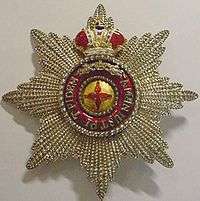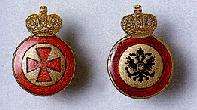Order of St. Anna
| Imperial Order of Saint Anna Орден Святой Анны | |
|---|---|
 | |
| Star of the Order | |
| Awarded by | |
| Type | Dynastic Order |
| Royal house | House of Romanov |
| Religious affiliation | Russian Orthodox |
| Ribbon | Bright Red with thin Yellow stripes on either side. |
| Motto | Amantibus Justitiam, Pietatem, Fidem To those who Love Justice, Piety, and Fidelity |
| Status | Rarely constituted |
| Sovereign | Grand Duchess Maria Vladimirovna of Russia |
| Grades (w/ post-nominals) | Knight/Dame Grand Cordon Knight/Dame Commander Knight/Dame Officer Knight/Dame |
| Established | 14 February 1735 1735 – 1918 (National Order) 1918 - Present (House Order) |
| Precedence | |
| Next (higher) | Imperial Order of St. Prince Vladimir |
| Next (lower) | Imperial Order of St. Nicholas the Wonderworker |
| | |
| The Ribbon of the Order | |
The Order of Saint Anna (also "Order of Saint Ann" or "Order of Saint Anne") Russian: Орден Святой Анны was established as a Holstein ducal and then Russian imperial order of chivalry established by Karl Friedrich, Duke of Holstein-Gottorp, on 14 February 1735, in honour of his wife Anna Petrovna, daughter of Peter the Great of Russia. The motto of the Order is "Amantibus Justitiam, Pietatem, Fidem" ("To those who love justice, piety, and fidelity"). Its festival day is 3 February (New Style, 16 February). Originally, the Order of Saint Anna was a dynastic order of knighthood; but between 1797 to 1917 it had dual status as a dynastic order and as a state order. The Head of the Imperial House of Russia always is Master of the imperial Order of Saint Anna.[1] The Order of St. Anna continued to be awarded after the revolution by Grand Duke Kirill Vladimirovich, Grand Duke Vladimir Kirillovich, and Grand Duchess Maria Vladimirovna. Today, the Russian Imperial Order of St. Anna, awarded by Grand Duchess Maria Vladimirovna is recognized as a legitimate order of chivalry by ICOC,[2] and the direct continuation of the pre-Revolutionary order, while this is disputed by some historians and by some members of the Romanov Family Association. [3]
Membership of the Order was awarded for a distinguished career in civil service or for valour and distinguished service in the military. The Order of Saint Anna entitled recipients of the first class to hereditary nobility, and recipients of lower classes to personal nobility. For military recipients, it was awarded with swords.[4] It is now usually awarded for meritorious service to the Imperial House of Russia.
History
At first, the Order had but one class and was named the "Order of Anna". The statutes of the Order promulgated in 1735 established as the principal insignia a red-enameled gold cross, with an image of Saint Ann imposed upon the centre of the cross; the reverse bore the initials "A.I.P.F." (for "Anna Imperatoris Petri Filia": "Anna, Emperor Peter's daughter" in Latin). The same letters also abbreviate the Latin motto (as the letter "J" did not exist in Latin, "Iustitiam" was the original spelling of the word now rendered "Justitiam").
In 1742, Karl Peter Ulrich, Duke Karl Friedrich's son, was declared the Russian heir apparent. After arriving in Russia, he presented the Order to several courtiers. On 15 April 1797, his own son, Emperor Paul I of Russia, established the Order as part of the Imperial Russian system of honours and divided it into three classes, renaming it the "Order of Saint Anna". Emperor Alexander I added a fourth class in 1815.
Recipients of the Order of St. Andrew (including princes of the Imperial blood, who received it at baptism) simultaneously received the first class of the Order of Saint Anna. The Emperor himself was the hereditary chief of the Order.
The title of Chekhov's well-known story Anna on the Neck refers both to the Order and to the heroine.
Insignia
-

Order of St. Anna, 1st class
-

Order of St. Anna, 2nd class (The example shown is "with swords", for bravery in battle, and crown)
-

Order of St. Anna, 3rd class
-

Order of St. Anna, 4th class (The insignia with imperial eagle would have been awarded to a non-Christian, for whom a Christian cross was deemed inappropriate)
Methods of Wear
- 1st class: Cross worn at the bow of a broad ribbon (ten centimeters wide, worn over the left shoulder), on the right hip; star of the Order (about 95 millimeters in diameter) worn on the right breast;
- 2nd class: Cross worn on a neck ribbon 45 millimeters wide;
- 3rd class: Cross worn on the left ribbon, suspended from a ribbon 28 millimeters wide;
- 4th class: Cross borne on the pommel of an edged weapon, together with a silver-tasselled sword-knot of the ribbon of the Order.
The medal ribbon was red with narrow yellow edging.[5]
A recipient of higher classes of the Order would not wear insignia of lower classes, unless he had also been awarded the fourth class (the insignia of which was borne on the hilt of a sword or other edged weapon).
Bibliography
Alan W. Hazelton, The Russian Imperial Orders; New York: The American Numismatic Society, 1932 (Numismatic Notes and Monograms, No. 51).
References
- ↑ "Official site of Imperial Order of St.Anna, by Chancellery of Imperil House of Russia".
- ↑ "Dynastic Orders". International Commission on Orders of Chivalry. Retrieved 3 March 2014.
- ↑ Sainty, Guy Stair (2006). World Orders of Knighthood and Merit. London: Burke's Peerage. ISBN 0971196672.
- ↑ "Order of St Anne". Retrieved 27 April 2010.
- ↑ "Imperial Russia: Order of St Anne". Retrieved 27 April 2010.
External links
| Wikimedia Commons has media related to Order of St. Anna. |
- (Russian) Order of St. Anna
- (Russian) History of the order of St. Anna